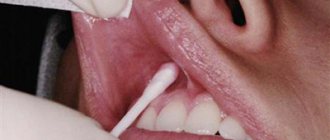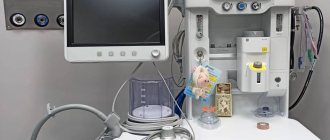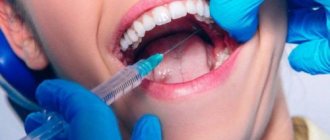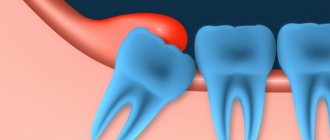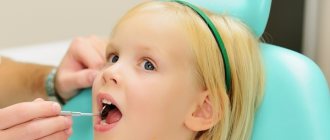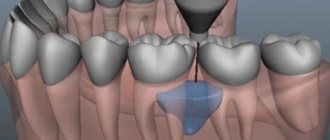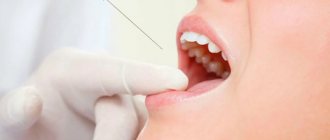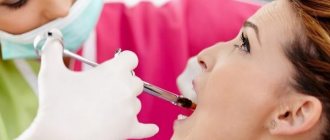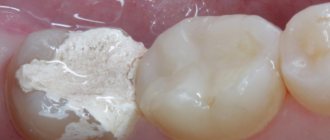Dentistry under sedation is a modern method that allows you to go through an unpleasant procedure with comfort. Parts of the brain responsible for increased levels of anxiety are temporarily blocked with anesthetic drugs. Under their influence, a person quickly calms down, falls into a shallow sleep, while remaining conscious. Ideal conditions are created for the doctor’s comfortable work, helping to significantly improve the quality and efficiency of procedures and perform a large volume in one appointment.
What is sedation in dentistry? How is it different from anesthesia or anesthesia?
Anesthesia in dentistry – anesthesia of the treatment area (site). This is a mandatory manipulation - a traditional injection into the gum near the diseased tooth.
Sedation is a light medical sleep that relieves anxiety and fear. The patient in this state is asleep, but conscious, feels touch, hears the doctor. The main difference from anesthesia is that during sedation a person breathes completely independently. Sedation is accompanied by local anesthesia so that it is not scary or painful. Sedation allows the doctor to monitor the condition of a patient with concomitant diseases - kidney or heart problems, high blood pressure - so all procedures are comfortable and as safe as possible.
Anesthesia or general anesthesia is used during hospital treatment when a complex operation needs to be performed. In this case, the patient’s consciousness is completely turned off, local anesthesia - injections into the gums - is no longer needed, and breathing is controlled by equipment.
The use of sedation assumes the preservation of standard reflexes and the absence of depression of the nervous system. According to reviews from patients of different ages, during treatment they feel lightness and relaxation. On average, an hour after the end of the procedure, the person returns to his normal state and can go home with an escort. Our clinic has a small room where you can rest and sleep after treatment under sedation.
Main indications and limitations for sedation in dental treatment in children
Among the main indications for the use of nitrous oxide are:
- childhood;
- uncontrollable fear of visiting a dentist;
- painful and traumatic treatment procedures;
- the need for complex manipulations.
The technology is recommended when a child is undergoing an invasive intervention that will take at least half an hour. But at the request of the parents, it can also be carried out for simple manipulations if the child is very afraid of going to the dentist. It is worth noting that the use of gas does not eliminate the need for anesthesia, but significantly facilitates it. Traditional local anesthesia is used along with sedation. Under the influence of sedatives, the baby will not feel the painkiller injection.
Despite the safety and other advantages of the technology, its implementation is not always possible. Absolute and relative contraindications include:
- high intracranial pressure;
- nasal breathing disorders (various pathogenesis);
- epileptic seizures;
- serious deviations from the nervous system;
- exacerbation of otitis media;
- recent traumatic brain injury.
There is a small risk of developing an allergic reaction. As a rule, it appears immediately, in the first few minutes after the implementation of the technology. In such a situation, the doctor stops the treatment process and uses the necessary antihistamines.
Types of sedation: superficial and deep
The following sedative methods of relaxing and calming patients are used in dentistry:
- Superficial is the best solution in a situation where the patient requires relaxation for a short period of treatment. Indicated for adults, as well as children from the age of three. A state of pleasant slumber is achieved by inhaling oxygen mixed with nitrous oxide. The nasal mask through which the gas passes is connected to the machine. The doctor can change the ratio of components and dosage based on the individual characteristics of the patient.
- Deep - the medication is administered through an intravenous injection. This technique copes better with severe fear and anxiety. The technique is used for adults and children at least 15 years old. The relaxed state lasts longer than with a superficial state. The patient will need to stay in the clinic for some time and stop driving for 8 hours.
Anesthesiologists at the Refformat dental clinic in Moscow have been working with a wide variety of patients for a long time and their experience makes treatment safe. Any intervention, preparation and installation of prostheses will be comfortable and unnoticeable.
Reviews
The first visit to the dentist can be a daunting experience for children and their parents. In each of the clinics of the Natadent network, we have created a truly warm and comfortable environment. We welcome every feedback - you help us become better.
LEAVE FEEDBACK
How is the sedation procedure performed?
The procedure consists of several stages. First, you need to get a consultation with a dentist - you meet the doctor and draw up a treatment plan.
For sedation, the patient will need to do a few simple tests:
- ECG.
- Donate blood for general analysis and biochemistry (detailed).
- Donate blood and get test results for hospitalization (for syphilis, HIV, hepatitis).
- If you have diseases, obtain permission from a specialized specialist.
The finished results are sent to the clinic administrators. Be sure to write the surname, initials of the patient and the dentist. The documents are submitted for review to the anesthesiologist, who decides on admission to the operation under sedation and takes into account the possible consequences.
The administrator contacts the patient to clarify the date and time of arrival at the center. On the appointed day, it is recommended to arrive early for the appointment, but do not use personal transport. If necessary, administrators will help you call a taxi to get you back home.
Before the procedure begins, there is a conversation with the anesthesiologist. In the operating room, an individually selected dose of anesthetic will be administered through a nasal catheter and wire. Unlike anesthesia, the patient continues to breathe on his own, plunging into a pleasant half-sleep, without negative sensations. At the end of treatment, the patient is escorted to the rest room, where he has the opportunity to lie down and rest.
Who is an anesthesiologist?
Anesthesiology is a branch of medicine that studies means and methods of providing anesthesia (that is, loss of sensitivity, including pain) for various acute pain syndromes, shock conditions, injuries, and surgical interventions. An anesthesiologist is a specialist who specializes in anesthesiology. This is one of the most erudite and responsible professions of all existing medical specialties. The anesthesiologist has first-class knowledge in all fundamental areas of medicine. He knows how the entire body works as a whole and each of its functional systems, each internal organ, each cell of the body.
As soon as this medical specialty appeared, it immediately became possible to perform surgical interventions without pain, stress and severe, life-threatening complications. The anesthesiologist is equipped with all the knowledge and modern technical capabilities necessary to minimize the risk of fatal complications during the surgeon's operation.
The work of an anesthesiologist is not only about competent and effective pain relief. His work begins even before the operation, with a study of the patient’s medical history and a personal conversation with him. From the patient he learns about his chronic and previous diseases, operations using anesthesia, allergic reactions to medications or food. Taking this information into account, a preliminary analysis of the functioning of the heart, lungs, blood vessels, kidneys and liver is carried out, tests and additional studies are prescribed. All this is necessary for the correct administration of anesthesia during surgery and minimizing the development of possible risks to the patient’s life. Only an anesthesiologist determines the optimal type of anesthesia.
Before an operation or examination, he conducts a calming conversation with the patient. Its meaning is a friendly explanation of the procedure for using anesthesia and neutralizing the fear of surgery. The doctor tells the patient how to properly prepare for the upcoming anesthesia and surgery. It is important that, as a result of such contact, the patient and his family do not feel nervous and are confident in the professionalism of the anesthesiologist.
Methods of drug administration
Dentistry with sedation in Moscow is represented by various methods of administering medications: inhalation, oral and injection.
Inhalation method
Most often used in pediatric dentistry. The procedure uses nitrous oxide. “Laughing gas” evokes positive emotions in a child from visiting a doctor’s office and undergoing lengthy procedures. At the same time, the doctor’s work becomes significantly easier and more effective.
Oral route
Oral drug sedation is a method of calming in which a drug that eliminates agitation is taken an hour before the main treatment procedure begins. Using this sedation technique, an initial level of stress relief is provided, and the main stage, at which an anesthetic is administered intravenously or an oxygen mask is used, is facilitated.
Injection method
Intravenous sedation is recommended primarily during dental treatment in adults. The injection method involves administering drugs intravenously, directly into the hematopoietic bed. This method is good because it allows you to control the degree of both physical and emotional relaxation.
Indications for the use of pain relief
European and American dentists use sedation in dentistry when performing any manipulations. In Russia, such a procedure can not be performed in every clinic. Treatment and removal of teeth under sedation at Refformat dentistry allows patients to completely calm down and undergo all manipulations in complete relaxation.
Indications for use:
- Severe fear, fear of visiting the dentist, panic.
- Increased vomiting.
- The desire to receive a service with high comfort.
- Reduced pain threshold.
- The need for a long period of simultaneous treatment.
- Vascular or cardiac pathologies (additional consultation with a therapist is required).
- A symptom of cramped (enclosed) spaces.
- A sharp increase in blood pressure due to stress.
Is it somewhat safe?
- This procedure is completely safe for the body: xenon is inert, non-toxic and is completely eliminated through the lungs within 4 hours,
- there is a rapid restoration of consciousness - within 2-3 minutes after the end of the drug administration,
- pronounced analgesic effect, while the patient is conscious and can communicate with the doctor,
- There is practically no drug load on the heart, blood pressure remains normal,
- compatibility with any medications and anesthetics,
- ideal for both time-limited procedures (for example, treatment of one tooth) and long-term manipulations (for example, installation of a large number of dental implants).
In our clinics, treatment using xenon is carried out by professional doctors who have undergone appropriate training and are accredited. In addition, modern equipment is used for safe sedation. It is mandatory to diagnose the patient’s health condition and his individual characteristics in order to select the permissible dose of the drug. The operating rooms are equipped with a ventilator and a resuscitation kit, which are mandatory when carrying out such manipulations.
Contraindications
Sedation is not anesthesia, which has an extensive list of prohibitions on its use. Its negative impact on the human body is minimal. However, this gentle method of sedation also has a certain number of contraindications:
- individual intolerance, allergies to medications;
- colds, flu, ARVI;
- infectious diseases (tuberculosis, hepatitis);
- certain types of chronic diseases;
- myasthenia gravis;
- mental disorders;
- pregnancy;
- alcoholism, drug addiction.
FAQ
Is it possible to eat before anesthesia?
No you can not. And parents need to not only tell their child about this, but make sure that he doesn’t eat too many cookies from his secret reserves. The child is hungry, he will try to eat at least something. Anesthesia on a full stomach may result in vomiting during treatment or upon awakening. If it is “in the process of treatment,” then the substance can block the airways, which is not necessary for anyone.
How easy is the anesthesia to tolerate?
If all protocols are followed and the process is monitored by an experienced anesthesiologist, then everything goes without problems or any special side effects.
To do this, we comply with all protocols and everything that is necessary for complete safety. For example, here is a study that suggests that with proper anesthesia with propofol and isoflurane, all side effects after waking up last less than a day. But sometimes our hair just stands on end when a mother comes to our clinic after a not very proper anesthesia in another place. We usually catch these parents with a week's worth of food and the moral expectation of three days of continuous vomiting and dizziness after waking up. Here you immediately understand that in another place the general anesthesia did not go quite right.
Will he really wake up?
Yes. It's not a matter of probability, it's a matter of following protocol. You need to check the equipment, have a doctor with the required qualifications, and understand the characteristics of a particular patient. Then there will be no surprises. The process is closely monitored by an anesthesiologist-resuscitator, who is ready to intervene at any time and adjust the anesthesia parameters. He knows how to smoothly introduce and recover from anesthesia, and knows all the nuances of resuscitation measures in children.
I was told about doctors who are against anesthesia
Yes, this happens.
But I think that they are not entirely right and they simply do not have a good anesthesiologist. The safety of general anesthesia for the health and mental abilities of the baby is confirmed by numerous studies. For example, they took 19,296 children and studied their development after many anesthesia experiences up to the age of 20. The results prove that everything is fine, and the children are no different from their peers. At the same time, many sources still come to the conclusion that repeated anesthesia before the age of two is undesirable. In general, sometimes misunderstanding and fear of general anesthesia take strange forms among some doctors. I remember one wild case when a doctor tried to protect children from terrible anesthesia by replacing it with temporary suffocation with a towel. Binds, holds and treats half-strangled. Such a kind doctor. Moreover, in fact, she uses a version of raush anesthesia. It’s just that it was relevant several hundred years ago, when even ether anesthesia was not invented, and the only option to carry out a conditional amputation was a precisely calculated blow to the crown of the head with a wooden mallet. But it was difficult to control the “depth” of such anesthesia and guarantee successful awakening.
What happens to the eyes during treatment?
The eyes dry only during deep anesthesia; in our case, they are sufficiently moistened with tears. The patient's eyelids are fixed with a special plaster. This way the eyes remain closed and the mucous membrane does not dry out. Well, there is no risk that something could get into them.
Will hair fall out after surgery?
I know it sounds strange, but parents ask this. The point is this: if you lose a lot of blood during surgery, hair loss may be a side effect. But when a mistake is made in surgery, it is most often attributed to uncontrollable factors in the spirit of: “This is a drug for anesthesia,” and not to the fact that someone was unable to perform the manipulation on time or did not make the right decision. And the anesthesiologist has nothing to do with it.
Will this affect the child’s memory or damage the brain?
It won't have any effect - neither good nor bad. The anesthesiologist carefully monitors the saturation level so that the young brain receives enough oxygen. The device does not supply pure gas, but mixed with oxygen. All sensors are built into the ventilator. If necessary, the doctor can, for example, adjust the composition of the gas mixture. All drugs have an excellent safety profile and a bunch of studies confirming their safety when used in pediatric patients. We also know how to work quickly. If on very voluminous interventions we used to work for six hours, then up to four, up to three, now the average duration is no more than 2.5 hours: this, in particular, is why technology and a professional team are needed.
Will he have bad dreams?
Will not. The child will not remember the process of anesthesia itself and, most likely, some short period before it. Just try not to frighten him again: children are very impressionable. Then we will try to make everything as comfortable as possible for him: he fell asleep, woke up, and then played.
Pros and cons of sedation in dentistry
The main advantage of treatment, removal or prosthetics of teeth under sedation is that it is much easier and more convenient for the doctor to work with a patient who is in a relaxed state. The patient does not experience negative emotions and a persistent feeling of fear from visiting the doctor’s office. In the future, people will more often visit the dental clinic for preventive purposes.
The procedure also has disadvantages, although there are not many of them. The patient should spend an additional hour in the rest room. The cost remains quite high, which is fully explained by the high price of imported materials, high-quality equipment, as well as the duration of treatment. Initially, you will need to spend time and money on tests and consultation with specialists.
We know how to treat without pain!
- complete relaxation: you will have no fear of the dentist, pain or treatment,
- complete relief of pain,
- fast recovery,
- pleasant rehabilitation after, since xenon triggers metabolic processes in the body,
- you are relaxed, which means the doctor does his job without being distracted by your emotions.
With us you will stop being afraid of dentists! Individual selection of drugs, the most modern equipment and certified doctors who professionally work with all types of anesthesia.
Enroll now
Why is it so important not to scare a child?
The most difficult thing in dentistry is not to scare a child.
Unfortunately, this is often done for us by some strange grandparents who scare the child with doctors. Please never tell your children things like: “If you eat candy, you will ruin your teeth. And then the doctor will use a terrible drill to drill your teeth.” Sooner or later, a small patient will have to encounter a dentist. And we would like him to trust us, and not run away screaming at the sight of a white coat. Otherwise, everything can end with persistent dental phobia, a mouth full of dentures and a bunch of problems for life. PS
In previous posts about palatal expanders and the scientific approach to dentistry, you asked about the clinic. If you want to treat your teeth with us, then say “I’m from Habr”, there will be a small 5% discount.
